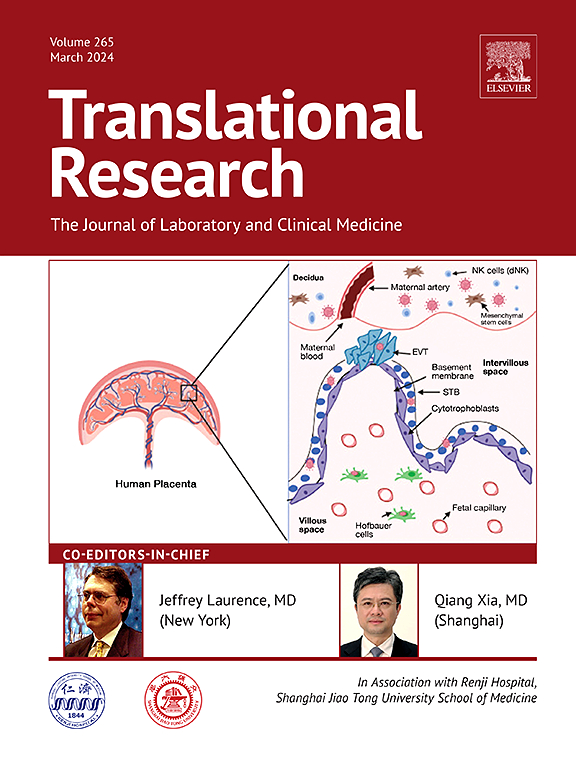Kv1.3 expression on CD4 (+) T cells promotes interleukin-17A-associated airway inflammation and airway remodeling in asthma
IF 5.9
2区 医学
Q1 MEDICAL LABORATORY TECHNOLOGY
引用次数: 0
Abstract
Background
Different types of T helper cells play an important role in disease severity and treatment response in patients with asthma. The potassium channel Kv1.3 is a type of potentially therapeutic target in T-cell-mediated inflammatory diseases.
Objective
This study aimed to explore the potential of Kv1.3 as a therapeutic target for asthma and to assess the efficacy of the Kv1.3 inhibitor PAP-1 in the treatment of asthma.
Methods
Kv1.3 expression on CD4+T cells was determined using data from public databases. CD4+T cells were isolated from peripheral blood samples obtained from healthy individuals and patients with asthma. The mouse models of OVA-induced asthma and Kv1.3 knockout were established. The underlying mechanism was investigated using mouse splenic CD4+T cells and BEAS-2B cells. OVA-induced asthmatic mice were treated with the Kv1.3 selective blocker PAP-1.
Results
Based on public data, we determined the distribution of Kv1.3 on CD4+T cells, its up-regulation in asthma, and its correlation with Th17/Treg balance. Upregulation of Kv1.3 in CD4+T cells was associated with enhanced activation of these cells and airway inflammation in patients and mice with asthma, accompanied by increased IL-17A levels in alveolar lavage fluid. Conversely, Kv1.3 deficiency significantly attenuated airway inflammation, lowered IL-17A levels in bronchoalveolar lavage fluid, and inhibited airway epithelial-mesenchymal transition in asthmatic mice. Furthermore, treatment with the Kv1.3 selective blocker PAP-1 attenuated inflammation in lung tissues and prevented airway remodeling in OVA-induced asthmatic mice.
Conclusions
Kv1.3 expression on CD4+ T cells was correlated with IL-17A-associated airway inflammation and remodeling in asthma, which may be regarded as a potential diagnostic marker and therapeutic target for asthma.
Translational significance
Based on our study, Kv1.3 expression on CD4+T cells was correlated with IL-17A-associated airway inflammation and remodeling in asthma, which may be regarded as a potential diagnostic marker and therapeutic target for asthma. The treatment with the Kv1.3 selective blocker PAP-1 attenuated inflammation in lung tissues and prevented airway remodeling in OVA-induced asthmatic mice. Our discoveries offer novel perspectives for a better understanding of IL-17A-associated airway remodeling in asthma. The development of drugs targeting Kv1.3 holds application value for IL-17A-associated asthma.

Kv1.3在CD4 (+) T细胞上的表达可促进哮喘患者白细胞介素- 17a相关的气道炎症和气道重塑
不同类型的辅助性T细胞在哮喘患者的疾病严重程度和治疗反应中起重要作用。钾通道Kv1.3是t细胞介导的炎症性疾病的一种潜在治疗靶点。目的探讨Kv1.3作为哮喘治疗靶点的潜力,评估Kv1.3抑制剂PAP-1治疗哮喘的疗效。方法利用公共数据库数据检测CD4+T细胞中skv1.3的表达。从健康个体和哮喘患者的外周血样本中分离出CD4+T细胞。建立ova致哮喘小鼠模型和Kv1.3基因敲除模型。利用小鼠脾CD4+T细胞和BEAS-2B细胞研究其潜在机制。用Kv1.3选择性阻断剂PAP-1治疗ova诱导的哮喘小鼠。结果基于公开数据,我们确定了Kv1.3在CD4+T细胞上的分布、哮喘患者Kv1.3的上调及其与Th17/Treg平衡的相关性。在哮喘患者和小鼠中,CD4+T细胞中Kv1.3的上调与这些细胞的激活增强和气道炎症有关,并伴有肺泡灌洗液中IL-17A水平升高。相反,Kv1.3缺乏可显著减轻哮喘小鼠气道炎症,降低支气管肺泡灌洗液中IL-17A水平,抑制气道上皮-间质转化。结论skv1.3在CD4+ T细胞上的表达与il - 17a相关的哮喘气道炎症和气道重构相关,可作为哮喘的潜在诊断标志物和治疗靶点。根据我们的研究,Kv1.3在CD4+T细胞上的表达与il - 17a相关的哮喘气道炎症和重塑相关,可作为哮喘的潜在诊断标志物和治疗靶点。Kv1.3选择性阻滞剂PAP-1可减轻ova诱导的哮喘小鼠肺组织炎症,阻止气道重塑。我们的发现为更好地理解il - 17a相关的哮喘气道重塑提供了新的视角。靶向Kv1.3的药物开发对il - 17a相关哮喘具有应用价值。
本文章由计算机程序翻译,如有差异,请以英文原文为准。
求助全文
约1分钟内获得全文
求助全文
来源期刊

Translational Research
医学-医学:内科
CiteScore
15.70
自引率
0.00%
发文量
195
审稿时长
14 days
期刊介绍:
Translational Research (formerly The Journal of Laboratory and Clinical Medicine) delivers original investigations in the broad fields of laboratory, clinical, and public health research. Published monthly since 1915, it keeps readers up-to-date on significant biomedical research from all subspecialties of medicine.
 求助内容:
求助内容: 应助结果提醒方式:
应助结果提醒方式:


